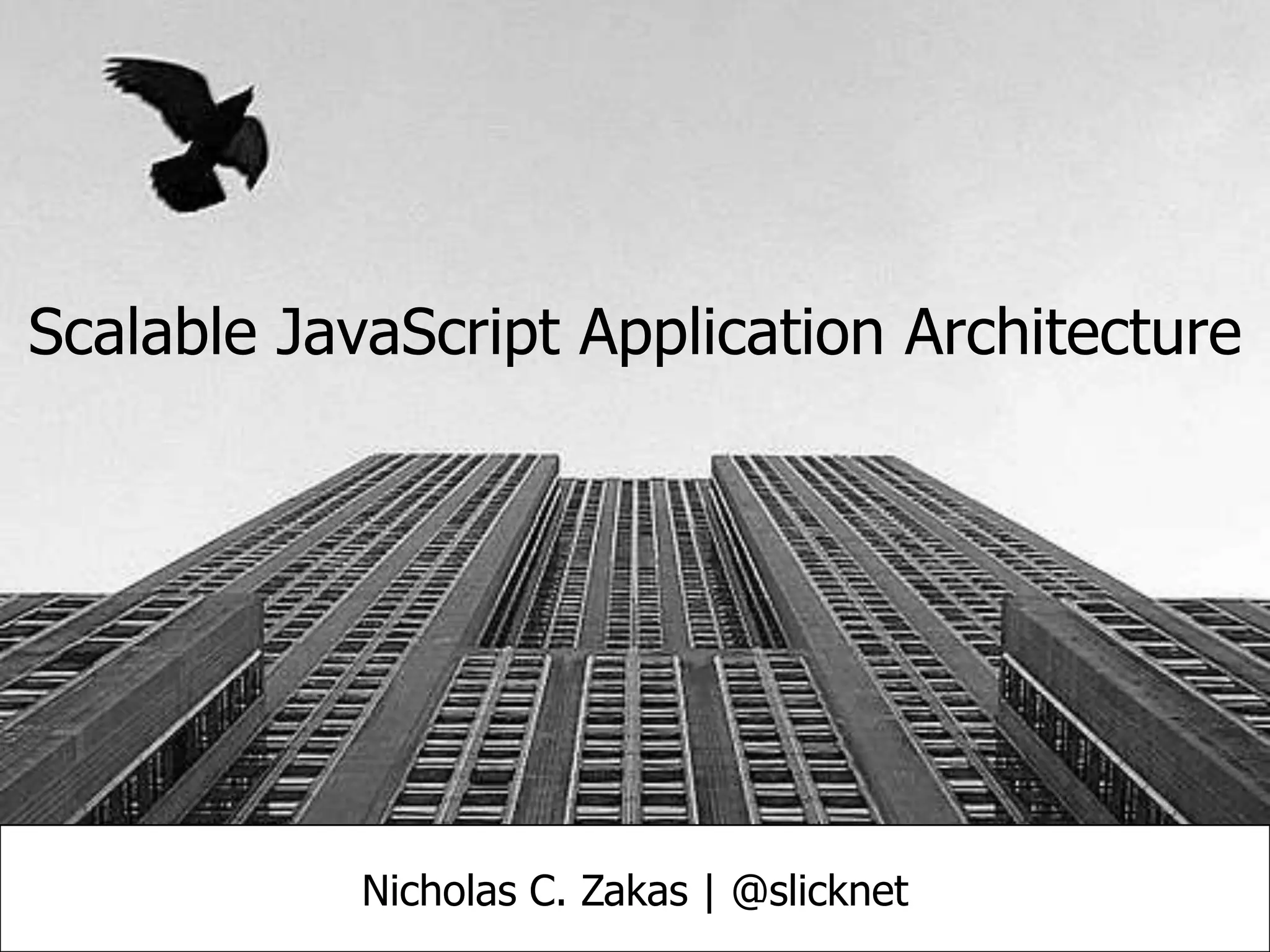The document outlines a scalable JavaScript application architecture based on the modular approach, emphasizing the use of independent modules that interact through a sandbox interface to promote loose coupling and maintainability. Each module is tasked with specific functionalities while remaining unaware of the overall architecture, ensuring that changes in one module do not affect others. The architecture framework supports extensibility, error handling, and promotes code reuse, making it adaptable for different applications.





















































![Core = function(){ var moduleData = {}; return { register: function(moduleId, creator){ moduleData[moduleId] = { creator: creator, instance: null }; }, start: function(moduleId){ moduleData[moduleId].instance = moduleData[moduleId].creator(new Sandbox(this)); moduleData[moduleId].instance.init(); }, stop: function(moduleId){ var data = moduleData[moduleId]; if (data.instance){ data.instance.destroy(); data.instance = null; } } } }();](https://image.slidesharecdn.com/scalable-javascript-application-architecture-2012-120607122646-phpapp01/75/Scalable-JavaScript-Application-Architecture-2012-54-2048.jpg)






![Core.register("timeline", function(sandbox){ return { init: function(){ sandbox.listen([ "timeline-filter-change", "post-status" ], this.handleNotification, this); Loose }, Coupling handleNotification: function(note){ switch(note.type){ case "timeline-filter-change": this.applyFilter(note.data); return; case "post-status": this.post(note.data); return; } } }; });](https://image.slidesharecdn.com/scalable-javascript-application-architecture-2012-120607122646-phpapp01/75/Scalable-JavaScript-Application-Architecture-2012-61-2048.jpg)


![Core = function(){ var moduleData = {}, debug = false; function createInstance(moduleId){ var instance = moduleData[moduleId].creator(new Sandbox(this)), name, method; if (!debug){ for (name in instance){ method = instance[name]; if (typeof method == "function"){ instance[name] = function(name, method){ return function(){ try { return method.apply(this, arguments);} catch(ex) {log(1, name + "(): " + ex.message);} }; }(name, method); } } } return instance; } //more code here }();](https://image.slidesharecdn.com/scalable-javascript-application-architecture-2012-120607122646-phpapp01/75/Scalable-JavaScript-Application-Architecture-2012-64-2048.jpg)












![Entrypoint var xhr = new XMLHttpRequest(); xhr.open("get", "/ajax?name=value", true); Request xhr.onreadystatechange = function(){ format if (xhr.readyState == 4){ if (xhr.status == 200 || xhr.status == 304){ var statusNode = xhr.responseXML.getElementsByTagName("status")[0], dataNode = xhr.responseXML.getElementsByTagName("data")[0]; if (statusNode.firstChild.nodeValue == "ok"){ handleSuccess(processData(dataNode)); } else { Response handleFailure(); format } } else { handleFailure(); } } }; xhr.send(null); Basic implementation Lowest-level Ajax with XMLHttpRequest](https://image.slidesharecdn.com/scalable-javascript-application-architecture-2012-120607122646-phpapp01/75/Scalable-JavaScript-Application-Architecture-2012-77-2048.jpg)
![Library reference Entrypoint var id = Y.io("/ajax?name=value", { method: "get", Request on: { format success: function(req){ var statusNode = req.responseXML.getElementsByTagName("status")[0], dataNode = req.responseXML.getElementsByTagName("data")[0]; if (statusNode.firstChild.nodeValue == "ok"){ handleSuccess(processData(dataNode)); } else { Response handleFailure(); format } }, failure: function(req){ handleFailure(); } } }); Implementation using a library Hides some of the ugliness but still tightly coupled to Ajax implementation](https://image.slidesharecdn.com/scalable-javascript-application-architecture-2012-120607122646-phpapp01/75/Scalable-JavaScript-Application-Architecture-2012-78-2048.jpg)


![GET ?name=value&name=value /request Request format Entrypoint Response format { status: "ok|error", data: { results: [ "...", "..." ] } }](https://image.slidesharecdn.com/scalable-javascript-application-architecture-2012-120607122646-phpapp01/75/Scalable-JavaScript-Application-Architecture-2012-81-2048.jpg)
































